|
|
|
Sort Order |
|
|
|
Items / Page
|
|
|
|
|
|
|
| Srl | Item |
| 1 |
ID:
178164
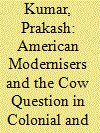

|
|
|
|
|
| Summary/Abstract |
The cattle modernisation sought by American missionaries in colonial North India advanced a productivist argument around the efficiency of cattle and their contribution to agriculture. On the face of it, by criticising the excessive supply of cattle in North India, this position went against the core preservationist concerns of the cow protectionists. But in reality, these modernisers struck a range of correlations with colonial and nationalist positions on the management of livestock and, ironically, even some limited space with the cow protectionists in treating India’s cattle as productive beings that were beneficial to the nation. These American prescriptions were stable constructs that became visible once again in the American food aid apparatus in India after Independence and shared overlapping concerns with ongoing cattle productivity debates in India. This paper illuminates the overlaps between the advocacy of the multiple constituents and a recurrence of certain patterns of contestation that were constitutive of the very paradigm of agrarian modernisation.
|
|
|
|
|
|
|
|
|
|
|
|
|
|
|
|
| 2 |
ID:
106449
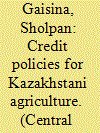

|
|
|
|
|
| Publication |
2011.
|
| Summary/Abstract |
This paper reviews the characteristics of the agricultural credit policy in Kazakhstan with a particular focus on emerging rural financial institutions. It is not easy to evaluate the real effect of credit policies due to the limited funds directed at agricultural production. Kazakhstani experience shows that commercial banks are used almost exclusively to provide agricultural producers with credit, while the new specialized credit institutions emerging in the agricultural sector only cater to a very small fraction of the total demand for credit. Presently, there are discussions in Kazakhstan concerning the creation of a specialized agricultural bank; however, this idea has some shortcomings that should be taken into consideration. Lack of credit is one of the main reasons for insufficient investment in agriculture. The underdeveloped land market in Kazakhstan makes formal credit institutions very cautious about accepting agricultural land as collateral.
|
|
|
|
|
|
|
|
|
|
|
|
|
|
|
|
| 3 |
ID:
152176
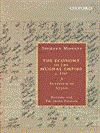

|
|
|
|
|
| Edition |
revised and enlarged ed.
|
| Publication |
New Delhi, Oxford University Press, 2015.
|
| Description |
xii, 476p.: maps, figurespbk
|
| Standard Number |
9780199450541
|
|
|
|
|
|
|
|
|
|
|
|
Copies: C:1/I:0,R:0,Q:0
Circulation
| Accession# | Call# | Current Location | Status | Policy | Location |
| 058994 | 954.0254/MOO 058994 | Main | On Shelf | General | |
|
|
|
|
| 4 |
ID:
078278
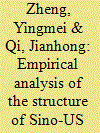

|
|
|
|
|
| Publication |
2007.
|
| Summary/Abstract |
This paper empirically analyzes the structure of agricultural trade between China and the USA from 1996 to 2005, using different trade indexes such as the Grubel-Lloyd Index, the Revealed Comparative Advantage Index, the Finger-Kreinin Similitude Index and the Export Diversification Index, with a focus on the issues impeding Sino-US agricultural trade. We found that over the period of 1996 to 2005, inter-industry trade outweighed intra-industry trade in Sino-US agricultural trade, and that bilateral trade was more complementary than competitive. At the same time, China's agricultural exports were more diversified than USA exports, but China's degree of diversification steadily declined during the sample period. The findings indicate that there exists great potential for further development of agricultural trade between China and the USA, and that positive and effective trade policies will result in maximization of potential agricultural trade development and will bring forth mutual benefits to both countries
|
|
|
|
|
|
|
|
|
|
|
|
|
|
|
|
| 5 |
ID:
121112
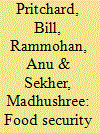

|
|
|
|
|
| Publication |
2013.
|
| Summary/Abstract |
Contemporary India possesses a food security paradox-progress in combating food insecurity is occurring at a slower pace than might be expected, given the nation's rapid economic growth. This paper provides a conceptual framework to explain this phenomenon. Drawing on the work of Amartya Sen, it uses a broadly framed analysis to conceptualise the problem in terms of the interactivity between three types of entitlement failure. Firstly, pure exchange system entitlement (abilities to obtain food from welfare programmes) has been curtailed by institutional shortcomings in pivotal programmes. Secondly, opportunities for wage-labour entitlement (abilities to obtain food from monetary incomes) have been restricted for vulnerable households because of the sequencing and geographical patterning of recent economic growth in India. Thirdly, opportunities for vulnerable households to address their needs through own-production entitlement (abilities to grow one's own food) have been curbed by land fragmentation and environmental degradation. These interactions have created vicious cycles of food insecurity for vulnerable households. Through this approach, the deeper causal roots of India's food security paradox are articulated, thus underscoring the importance of multi-pronged, holistically constructed policy agendas.
|
|
|
|
|
|
|
|
|
|
|
|
|
|
|
|
| 6 |
ID:
135066
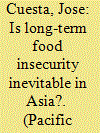

|
|
|
|
|
| Summary/Abstract |
This article questions two widely accepted claims on long-term food insecurity in Asia, the world's (heterogeneous) region with the largest number of undernourished individuals. The first claim is that food production may not grow as fast as the pace of population growth in Asia, which will reach 5 billion by 2050. The second claim is that an unstoppable emergence of a middle class in Asia will dramatically change the composition of food demand. On the first claim, the region's contribution to high and volatile international food prices is well known, but Asia's potentially positive contributions toward future price uncertainty and productivity growth are much less cited. On the second claim, the changing composition of future food demand in the region will depend on the extent that poverty reduction effectively leads to middle class expansion, which it is not an automatic process, and its extent still remains to be seen. Past evidence teaches us that poverty reduction on its own will not do the job of eradicating hunger, nor will only increasing food production. The jury is still out, but doomsday predictions are not necessarily justified.
|
|
|
|
|
|
|
|
|
|
|
|
|
|
|
|
| 7 |
ID:
114173
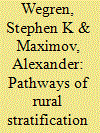

|
|
|
|
|
| Publication |
2012.
|
| Summary/Abstract |
Employing survey data and fieldwork from the Republic of Komi, this article demonstrates that sources of stratification such as food sales, land expansion and household business, that have a significant effect in regions favourable to agricultural production, do not have a similar impact on household stratification in this forested region. The differing effects of entrepreneurial activity in Komi may be attributed to the household employment structure in which agricultural employment is a minority. As a result, the primary source of stratification is employment income, not entrepreneurship.
|
|
|
|
|
|
|
|
|
|
|
|
|
|
|
|
| 8 |
ID:
147623


|
|
|
|
|
| Summary/Abstract |
This paper evaluates the impact of village-level land reallocations in China on household economic outcomes. The primary objective is to analyze the effect of short-term differences in tenure security in the year of a reallocation, employing the past history of land shifts as a source of exogenous variation in current tenure security. The results show that a decrease in the probability of losing the current plot yields an increase in agricultural inputs and production with no change in non-agricultural investments, conditional on household fixed effects that control for any unobserved and time-invariant characteristics of the household. This suggests that even small increases in the security of tenure enjoyed by households could yield benefits in terms of greater agricultural output.
|
|
|
|
|
|
|
|
|
|
|
|
|
|
|
|
| 9 |
ID:
143389
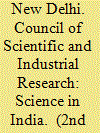

|
|
Science in India
/ New Delhi. Council of Scientific and Industrial Research
|
1966

|
|
|
|
| Edition |
2nd ed.
|
| Publication |
New Delhi, CSIR, 1966.
|
| Description |
70p.: ill.pbk
|
|
|
|
|
|
|
|
|
|
|
|
Copies: C:1/I:0,R:0,Q:0
Circulation
| Accession# | Call# | Current Location | Status | Policy | Location |
| 001657 | 509.54/NEW 001657 | Main | On Shelf | General | |
|
|
|
|
| 10 |
ID:
189308
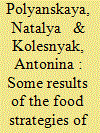

|
|
|
|
|
| Summary/Abstract |
This article presents a comparative macroeconomic analysis of the results of agricultural policy in the area of food security in Russia. China, and Japan. Russia has a lot more agricultural land - a factor of basic importance in food production - than its eastern neighbors China and Japan. China is the leader in terms of gross agricultural production, especially in cereal crops and grain legumes, stone fruits, berries, citrus fruits and grapes, vegetables, melons and gourds, as well as eggs. With respect to those products, China has complete self-sufficiency, but at the same time, the country experiences shortages in its own production of potatoes, meat, and milk. Japan cannot fully supply its own stone fruits, berries, citrus fruits and grapes, vegetables, melons and gourds, as well as meat and milk. Russia also has a shortage in its production of those products, with the exception of meat, of which it has ample supply. The average Russian citizen does not consume enough vegetables, melons and gourds, as well as milk and dairy products, for which there is a low level of self-sufficiency and economic accessibility in the country.
|
|
|
|
|
|
|
|
|
|
|
|
|
|
|
|
|
|
|
|
|